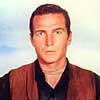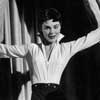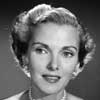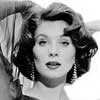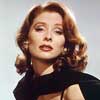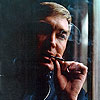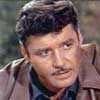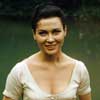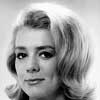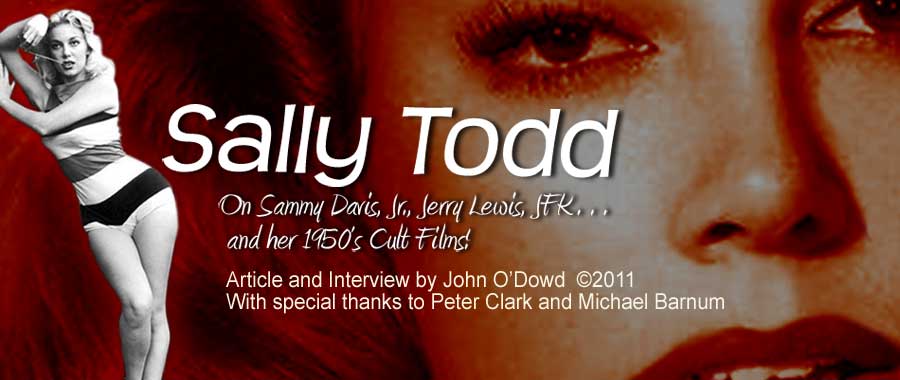William Ramage – The Diary of a 1950’s Male Model – Page 4
| Last Update: 1/1/2009 | |||||||||||
Page 4 of 6
BR: If the preceding individuals were tragic—and they are—then the life of Barbara Payton has to be right out of Grand Guignol horror! I had two very memorable (and distinctly different) meetings with Barbara. I met her the first time in the fall of 1958. It was at a small dinner party up on Sunset Plaza Drive, at the beautiful hilltop home of Milton and Charlene Golden. Mr. Golden was Barbara’s longtime attorney, and he was a close friend of mine, as well. Barbara and Charlene had spent the afternoon and the previous day reupholstering Milt’s favorite chair and ottoman in his home office. Barbara had just returned from living in Mexico for three years and she looked absolutely beautiful. I thought she was a warm, elegant and incredibly charming girl. She and I had a wonderful conversation that night and I was greatly impressed by her. I noticed when I was talking to her, Barbara hung on every word I said like it was the most important thing she had ever heard.
The dinner party that night was a bit of subterfuge, really. Leonard Fruhman, a young assistant to the famed interior designer Irving Longionotti, had escorted Evelyn Stebbins, a socialite friend of the Goldens and Barbara, and I had brought my good friend, actress Joan Caulfield. Leonard wanted to inspect the work Barbara had done on the chair and the ottoman—with the prospect of Mr. Longionotti offering her a job. It would have been a great opportunity for her, however Barbara didn’t seem interested in getting a regular nine-to-five job. She wanted desperately to get her film career rolling again, but by then it was a lost cause. When Milton tried to talk to her after dinner—just the two of them, off in a corner of the terrace at his home—about getting a full-time job outside the film industry, Barbara wouldn’t hear any of it! Even though her finances at the time were almost non-existent, Barbara was adamant about getting back into show business. She insisted she could get her career going again if she could just get one good acting job to let people know she was back from Mexico. She had even held an ill-advised press conference (in August 1958), which was basically a joke. There was nothing to announce, no new film or TV show. Just that she was “back in town”. Barbara’s previous bad publicity over the Franchot Tone/Tom Neal brawl and her arrest in 1955 for bouncing checks had ended any chance for a film career for her. The few reporters that were present at that press conference taunted her with cruel questions about her past and by the time they were finished grilling her, Barbara was very hurt and quite angry with them. Needless to say, her comeback never happened, and by 1959 Barbara was sliding downhill…fast. JO’D: Did you keep in touch with her after the dinner party in 58? BR: No, I didn’t see Barbara again until four years later. She was a completely different person by then…the things that happened to her in that four year span must have been appalling! One night in the fall of 1962, I saw her hitchhiking in the rain on the corner of Sunset Boulevard, off Gower Street by Columbia Square, so I stopped to give her a ride. I don’t even want to go into how bad she looked that night…let me just say it was hard to believe this was the same person who only a few years before had been so fetching and exquisite. Barbara acted confused and we barely spoke. She seemed to remember me from the Goldens dinner party because she did mention Joan (Caulfield) to me. Joan and I had driven Barbara home the night of the party to her little apartment on Ogden Drive, just off Sunset Boulevard. The night she was hitchhiking, she said she wanted to go to The Coach and Horses Bar in Hollywood. However, before we got there, she had me pull over. Barbara got out of the car and walked into the rain and the fog, and I never saw her again. A few years later she drank herself to death in her parents home. Barbara was basically a very nice person, but I believe it is possible she was mentally ill. She debased herself so inexplicably. Drugs…alcoholism… prostitution. She was truly one of the world’s lost souls. JO’D: Back then, a lot of these performers personal problems were revealed to the public by several Hollywood gossip columnists (Hedda Hopper, Louella Parsons, Walter Winchell) who were notorious for their tough and sometimes cruel reporting style. Did you know any of them well? BR: Only Walter Winchell…I wasn’t important enough to know the other two! I only met Hedda and Louella a few times. I sat next to Louella once on an airplane flight to New York from Los Angeles and we spoke briefly. Although I had heard, as did everyone, that she was quite a boozer, she didn’t touch a drop of alcohol during the flight. I do know that Hedda Hopper—if she liked you, that is—was a good and valuable person to have in your corner. Far tougher than either one of these women, though, was a nasty old bird named Florabel Muir, the Hollywood reporter for the New York Daily News. I know she absolutely despised Barbara Payton and often ripped her to shreds in her column. Florabel covered the beat for the LAPD and she knew all the dirt in town. She interviewed me once, in the RKO commissary. I remember her telling me that if I wanted to offer the press a beverage, “It better be booze, brother!” (laughs) Those ladies were powerful…and nasty! Walter Winchell, on the other hand, was my friend. He was kind to me and I won’t allow anyone to say a negative word about him. Sadly, Walter was already losing his power when I knew him. He had a little bungalow at The Ambassador Hotel and he loved to use the putting green on the grounds. I lived a couple of blocks away at The Talmadge Apartments on Wilshire Boulevard and he would often ask me to drive him to the studios for various screenings. I took him to Metro the first night they screened Sweet Bird of Youth (1962), a film in which he was on the telephone talking to Geraldine Page, but off-camera. When the scene appeared, he was as excited as a child. Newspaper people will never have the kind of captive audience they did back then. They really could make or break careers…and they did!
JO’D: Who would you say were among some of the nicest and most down-to-earth individuals you’ve known in show business? BR: Certainly Loretta Young, Barbara Stanwyck, Roger Moore, Efrem Zimbalist, Jr., Richard Chamberlain (a man of great humor), Steve Forrest and Patricia Barry. Patricia has done a lot of episodic TV through the years, and several soap operas. A kind lady, a great actress and a superb hostess. And Vera Miles—the greatest and most delightful person of all!
Loretta Young was very friendly and approachable (and very honest). Miss Stanwyck (“Missy”) was tough, but a most considerate lady. A thorough professional. Steve Forrest, who is Dana Andrews brother, was very personable and always a pleasure to talk to. He tells great stories! Roger Moore stood behind me in the blood drive line for The Red Cross once, at Warner Brothers. I enjoyed his total candor, and he was oh so British! As we were standing there in line waiting to give blood, he turned to me and said (with a stiff upper lip), “I am not fond of needles!” (laughs) Roger and I are still friends today. At Warners, a man named Bill Orr was Head of Television back then. His assistant was Hugh Benson and he and his wife Diane were later my neighbors and just about my best friends in Hollywood. They were two of the nicest people I ever met. Hugh was especially kind to young actors. JO’D: Speaking of Warner Bros.,you worked on quite a few WB television series in the late 50s to early 60s, including Hawaiian Eye and 77 Sunset Strip. Were you under contract to the studio at the time? BR: No, even though I worked there a lot, I was never under contract at Warners, only at RKO. Catherine Ehring, the secretary of WB casting director Hoyt Bowers, advised me that even if I was offered a contract with the studio, that I should refuse it. She told me they would never let me model, which was my chief source of income. Studio contract players in those days rarely were paid more than $750 a week. I knew I could always earn much more money modeling…and I did.
JO’D: There are some writers and self-professed film historians who make a habit of questioning an actor’s credits (and credibility) if they’re names are not listed on IMDb (The Internet Movie Database). How would you address these writers’ (sometimes quite vocal) skepticism? BR: Yes, I know of one or two doing research articles now who obviously do not know the circumstances of employment for television and film in an era when actors worked with no regard to being “historically saluted.” All I can say is what I know and experienced myself. Billing, which some of these so-called “historians” search for in actors’ credits, was of little consequence in the 1950s and 60s. In fact, I know of an instance where Connie Stevens who was a regular as Cricket Blake on Hawaiian Eye, did a silent bit on 77 Sunset Strip with no billing. She was paid, though, for her work, as we all were. Back then, actors did whatever work was assigned to them. Even Bette Davis who was one of Warner Brothers Studios top stars did a part once with no dialogue and no billing! It was in the first shots of a major movie and Bette was costumed as a nurse. Why don’t one of those writers who seem to consider their work so thorough and above reproach, tell film buffs the name of the feature and the circumstances under which this was done? Even ads for products such as Lux soap or Jarman shoes could be assigned with no additional remuneration. This is one reason why I did not want a studio contract. The modeling would have been a conflict of interest and I needed to make a living. JO’D: When you were working on a lot of the WB television shows in the early 1960s, were the shows themselves considered to be well written and of high quality? BR: The shows were very popular but the scripts were usually awful and were constantly being recycled. For instance, the same script for Sugarfoot was used on Bronco, the same script for 77 Sunset Strip was used on Bourbon Street Beat, and so on. Pretty clever, right? Jack L. Warner was cheap beyond words. He used to go around the studio at six pm sharp and turn off any lights that had been left burning! (laughs) That’s a true story, by the way…ask anyone who worked at WB back then! There were a lot of complaints about how WB treated actors in those days, but the studio always kept its contract players (and the rest of us) working. At the time, there were only 13,000 members in the Screen Actors Guild, and we all worked. Now, there are over 100,000 members and most are unemployed! JO’D: What kinds of roles did you play on the WB shows? BR: I played an assortment of playboys and cads, usually, with an occasional nice guy and a standard Western background character thrown in for good measure.(laughs) One role I did that I thought was kind of interesting was on Bourbon Street Beat. I played a Cajun lawbreaker just let out of jail who becomes involved in a ferryboat incident in Algiers, Louisiana. It was a lot different for me and I enjoyed it. I also worked in a pilot called Solitaire, with Richard Long. It didn’t sell, but I enjoyed working with Richard. He had a tragic life, and he, too, died young, at only 49. Go to Page 5 of 6 |
|||||||||||
Please leave a comment below. or visit my retired guestbook, to see previous comments.















